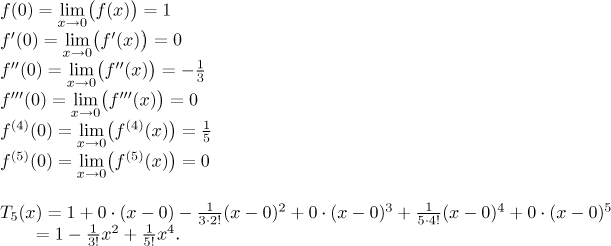27: The derivative

is so terrible that straightforward methods (find its derivative
f (7), check on critical points etc) do not work here. One
has to get rather devious, see
here, to find that
f (6) is in fact increasing on
[0,2] and thus
max = f (6)(2) = −19sin(2)/8 − 21cos(2)/4 = 0.02518950...,
min = lim 0 ( f (6)) = −1/7.
When taken in the absolute value, the maximu is given by the larger (in
absolute value) of the two, which is 1/7. Thus

Now we use it in estimating the error of integration.

Alternative: The calculations for Taylor's polynomial yield

Note that remarkably, this is exactly what one gets when finding the
T6 for sin(x) and then dividing it by x.
Then one gets

The error estimate needs the same maximum, so we get

The error estimate is worse, which is to be expected. The center
a = 0 is at one end of the integrating interval, so at the
other end the approximation is no longer as good, while the centre
a = π/2
is closer to the centre of this interval. Still, from practical point of view
this alternative approach is better, since the Taylor polynomial that we get
is simple
to extend further, we easily improve precision by taking for instance
T7, while for the centre
a = π/2
raising the degree would mean more really ugly derivatives.
Answer


![]()



